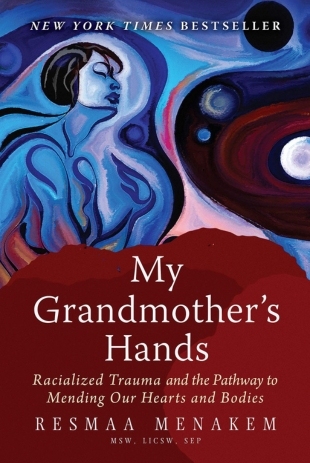My Grandmother’s Hands by Resmaa Menakem has the power to change not only the way we see the world but also the way we attempt to heal the world. It is bold, grounded, urgent, necessary, and it makes sense.
As a therapist whose work is centered on somatic practice, Menakem approaches the problem of white supremacy from the perspective of the body and its trauma; as a result, he translates the insufficient term “white supremacy” into the more apt term “white-body supremacy.” Every body in America – Menakem focuses on white bodies, black bodies, and police bodies — has been exposed to and absorbed the poisonous toxins produced by white-body supremacy; side-effects include antiblack racism, moral injury, toxic stress, the dangerous notion of white fragility, colorism, police brutality, and mass incarceration.
In a book that is just chock-full of needed, brilliant, and pragmatic insights, Menakem’s insistence that we locate the problem of racism in the body is not only his most fundamental but his most crucial contribution. It is because programs in antiracism have not started with the body that we have been stymied in our attempts to address racial divides:
“If you see white supremacy as a belief system or ideology, in this book you will discover only a fraction of it exists in our cognitive brains. For the most part, white supremacy lives in our bodies. In fact, white supremacy would be better termed white-body supremacy, because every white-skinned body, no matter who inhabits it — and no matter what they think, believe, do, or say — automatically benefits from it.”
He further argues that ending white-body supremacy cannot begin “with social and political action.” Before those can be effective, and not reactionary, bodies must be healed. “The real battlefield is inside our bodies,” he writes. “If we are to survive as a country, it is inside our bodies where this conflict will need to be resolved.”
Accordingly, Menakem has written a book that is driven as much by practices as it is by rich discussion of concepts related to trauma (intergenerational trauma, historical trauma, traumatic retention, dirty pain, clean pain, settled body, soul nerve). Every chapter contains a summary and a set of practices, both of which help the reader metabolize the content and their body’s responses to it. The expectation is that readers will take time to settle their bodies and check in after reading material that could activate fight, flight, or freeze. Since “trauma is all about speed and reflexivity,” Menakem’s strategy is to slow the reader down so that the book is healing and not re-traumatizing.
A key concept in the spiritual understanding of pain is that “the only way out is through.” Menakem’s review of American history shows, instead, a bypass at every step and reveals the spiritual deficit gaping in the heart of the United States: white-body supremacy first circulated and continues to circulate because white bodies have not faced the pain of their past and instead just keep blowing it into the future and into bodies of color.
White settlers brought to the United States the trauma of white-on-white violence and public torture experienced in Europe; instead of facing this trauma, they recreated it in the form of white-on-white violence and repression in their own communities (“Chapter 4: European Trauma and the Invention of Whiteness” brilliantly recasts a history most of us think we know). Then, once “whiteness” was invented, that still-unmetabolized trauma got “blown through” black and indigenous bodies in the form of slavery, removal, genocide, and countless other forms of psychological, social, political, and systemic violence. (The timeline of somatic history eras in “Chapter 5: Assaulting the Black Heart” is illuminating.)
Menakem is so good at illustrating how the spiritual deficit of unmetabolized trauma hurts all of us, and at every level of our lives (personal, interpersonal, cultural, communal, national). Ultimately, it sounds a death-knell for our systems and ideals. Unhealed trauma in police bodies appears yearly if not monthly in our courts, when police officers who have shot unarmed black bodies profess, “I was scared to death!” Menakem argues that phrases like this should, in many cases, be taken “very seriously” as “not a dodge but an honest description of a trauma-inspired fight, flee, or freeze — or, in many such cases, annihilate — response.”
To take such responses seriously is an uncomfortable step in the direction of healing, in that it connects a literal trigger mechanism with white-body supremacy. We are dangerously close to accepting as a valid legal defense, “I shot him because he’s black.” (In the words of a sign carried by one Black Lives Matter activist: “When the color of your skin is seen as a weapon, you will never be seen as unarmed.”)
While “a grown-up response to trauma is to heal it, not to blow it through other bodies — or blow holes in other bodies,” the United States has not yet grown up; Menakem does not mince words on this point. The message may not be comfortable, but discomfort is part of the healing, and healing can start with My Grandmother’s Hands.
